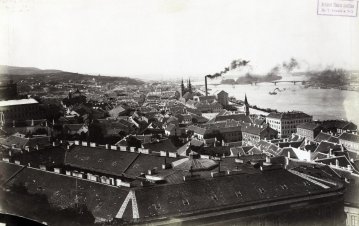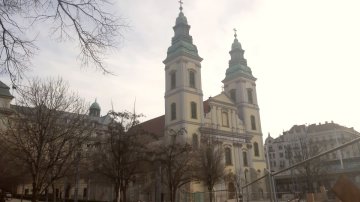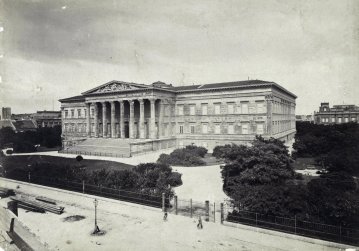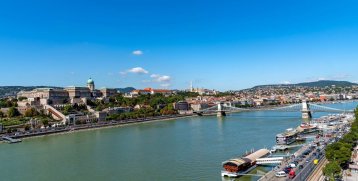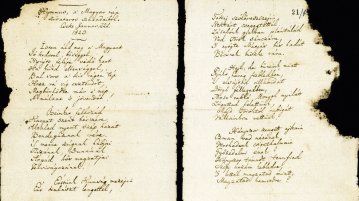 The „intertwined history” of the bridges and the city of Budapest
Which ideas and events have shaped the fate of bridges of Budapest and the cityscape? Alongside many other interesting facts, this question is also answered this newly published book by the Budapest City Archives, which introduces the history of bridges in Budapest.
The „intertwined history” of the bridges and the city of Budapest
Which ideas and events have shaped the fate of bridges of Budapest and the cityscape? Alongside many other interesting facts, this question is also answered this newly published book by the Budapest City Archives, which introduces the history of bridges in Budapest.
Search result
The father of the Lágymányos residential houses, architect József Fischer was born 150 years ago
February 14, 2023 at 12:30 PM
Architect József Fischer was one of the important creators of the large-scale residential house constructions that began at the beginning of the 20th century. His buildings still define the image of Lágymányos. If people walk from the direction of Szent Gellért Square on Bartók Béla Road towards Móricz Zsigmond Square, or walk over to Budafoki Road, from here they turn into Zenta Street, they can see several residential houses that he listed. He designed around 25 houses in the capital, most of which are still standing today. Pestbuda now commemorates József Fischer, who was born 150 years ago.
Hild Square in the 5th District will be beautified by autumn
February 13, 2023 at 6:00 PM
Many people do not even know that Hild Square in the 5th District, which is being renovated, did not exist as a public space before, because there was a building here until 1944-45. The basement level of the destroyed house has remained to this day, which makes it difficult to replace the soil. Despite the difficulties, many new trees will be planted, there will be new shaded areas, vertical green surfaces, new public benches, a table tennis table and an accessible playground. Residents of the area can take possession of the renovated area in autumn.
There was once a theatre in the Class Lottery Palace - The history of the theatre began 105 years ago on Eskü Square
February 12, 2023 at 9:00 AM
Where cars turn down today from the Erzsébet Bridge to the Pest embankment, before World War II, there stood a huge and beautiful building: the Class Lottery Palace. It was built at the turn of the century in the Neo-Baroque style, but Art Nouveau also left its mark on it. However, its interior was remodelled several times, most significantly for Vilma Medgyaszay's theatre. Jenő Lechner made its classicist plans in February 1918, exactly 105 years ago.
The meeting of two brilliant Hungarians with the florist - Donát Bánki and János Csonka patented the carburettor 130 years ago
February 11, 2023 at 1:00 PM
For a long time, the carburettor was an essential part of car engines. Its creators, János Csonka and Donát Bánki applied for a patent for this device on 11 February 1893. According to legend, the two friends got the idea while watching a flower seller on the Inner Ring Road.
The 125th anniversary of the death of Miklós Barabás was commemorated in the Fiumei Road Cemetery
February 10, 2023 at 2:00 PM
Miklós Barabás was one of Hungary's most significant artists, and on the occasion of the 125th anniversary of his death, a wreath was laid on Friday at his tomb in the Fiumei Road Cemetery, which was made by Ede Telcs. It was said at the event: the portraits of the painter are important documents of the era, indispensable sources of Hungarian memory.
A miracle in Budapest - The first talking film was greeted with thunderous applause 95 years ago
February 9, 2023 at 10:00 AM
The former Fórum cinema in Budapest played a key role in the spread of the sound film, which on 9 February 1928 presented a work in which people could hear the aeroplane buzzing, the goose cackling and the cows mooing.
One of the sharpest-minded Hungarians - The Budapest life of the young János Neumann
February 8, 2023 at 12:30 PM
The world considers him mostly a mathematician, but János Neumann was a great polymath of the 20th century. His achievements affect several scientific fields. He left Budapest when he was young, but his entire childhood was tied here: his excellent education and the years he spent in one of the best Hungarian secondary schools helped develop his brilliant mind. On 8 February, the 66th anniversary of his death, on the occasion of the Neumann Memorial Year announced for 2023, Pestbuda toured the main stations and locations of his life in the capital to recall his mind and personality.
The renovation of Nyugati Railway Station continues with spectacular developments
February 6, 2023 at 7:00 PM
In addition to the renovation of the north-west tower on the Teréz Boulevard facade of the Nyugati Railway Station, work will also begin on the south-east tower. The protective roof in front of the renewed facade is expected to be demolished in autumn.
Architect Ernő Schannen was a master of residential houses - He mastered design in the office of Ybl and Hauszmann
February 5, 2023 at 1:00 PM
Ernő Schannen is a little-known member of the architectural community at the turn of the century. However, his work significantly contributed to the development of Budapest's cityscape, he developed a unique style, in Pest and Buda we can find residential houses designed by him in many places, but he also created a hospital and a bank building, and also castles in the countryside.
Who should pay for the bridge? - The Pest and Buda horse-drawn railway companies merged 145 years ago
February 4, 2023 at 2:00 PM
The desire to save money forced the merger of the Pest and Buda horse-drawn railway companies because horse-drawn railway traffic was only allowed on Margit Bridge if the companies paid the additional cost of the wider bridge. Since the two companies could not agree on the use of the bridge, 145 years ago the larger, richer company bought the smaller one instead. This made it possible for horse-drawn railway transport to start between Pest and Buda a year later, in 1879.
Ernő Foerk, who built a church in a slum, was born 155 years ago
February 3, 2023 at 9:00 AM
Ernő Foerk is not one of Hungary's famous architects, but almost everyone knows his main work, the Votive Church of Szeged. A building very similar to it can also be found in Budapest, namely in Tripolisz of the 13th District, which was one of the capital's scariest neighbourhoods. The St. Michael's Parish Church, consecrated in 1930, brought light to the part of town with a dubious reputation.
On the way to Greater Budapest
February 2, 2023 at 12:30 PM
The area of Budapest has changed several times in the last 150 years. The unification of 1950, the creation of today's Budapest, did not come out of nowhere, at that time there had already been talking about developing Budapest and its surroundings for decades, and harmonising the ideas.
The first Hungarian Olympic champion became a famous architect - Alfréd Hajós was born 145 years ago
February 1, 2023 at 11:00 AM
Hungary is considered a great power in water sports, which was already foreshadowed by the glory of our first Olympic champion: Alfréd Hajós won Hungary's first gold in swimming. At the Athens competition, he was only eighteen years old, so he had to choose a career after his victory, and the swimmer nicknamed the Hungarian Dolphin became an architect. In the first half of the 20th century, Alfréd Hajós, who was born 145 years ago, achieved good results in this field as well, his works were of the high standard of the era.
The railings of the Chain Bridge are being painted
January 31, 2023 at 7:30 PM
They are already painting the railings and historical elements returning to the sidewalks of the Chain Bridge. A significant part of the bridge's 704-metre railing structure was remanufactured due to damage caused by rust. Eight arched parapet castings are reconstructed based on archival photos to match the appearance of the Chain Bridge in 1914-1915.
Artúr Görgei was remembered in the Fiumei Road Cemetery
January 31, 2023 at 4:00 PM
General Artúr Görgei, Minister of War, was remembered on the 205th anniversary of his birth at his grave in the Fiumei Road Cemetery. It was said: Görgei is a historical figure whose historical role has been found at both extremes of the scale from traitor to hero in the last 150 years.
The meeting of a unique sculptor and the cult of Arany - Description of a period with the help of a 130-year-old famous monument in Pest
January 31, 2023 at 9:00 AM
130 years ago the first public statue of János Arany was inaugurated in front of the main entrance of the Hungarian National Museum. In a new book that has just been published, not only is the entire history of the monument and the adventurous life of its creator, Alajos Stróbl, revealed to the readers, but they can also see how the people of the 19th century thought and debated, what they considered beautiful and right, what they were different from or just similar to people now. The book, which is also rich in images, is both a colourful introduction and an exciting description of a period.
Who painted Pest and Buda several times: Antal Ligeti was born 200 years ago
January 30, 2023 at 4:00 PM
Antal Ligeti, born 200 years ago, was one of the outstanding figures of Hungarian painting. He lived in extraordinary places, first in the Fót castle of Count Károlyi István, later in Budapest's most famous classicist palace: the National Museum building. He owed his first home to the support of the lord, who recognised the talent of the young painter and provided him with housing and board as a patron. He earned his home in the building of the National Museum as the keeper of the picture gallery, lived there for more than twenty years, and was taken to the cemetery from there.
Imre Madách, born 200 years ago, became a writer in Pest
January 28, 2023 at 9:00 AM
The young Imre Madách lived in Pest for three years. While completing his law studies at the University of Pest, he also got involved in social and cultural life. He regularly visited the performances of the Hungarian Theatre of Pest, attended concerts at the National Casino, but the highly educated young man also learned to paint, fence, and play the piano in the capital. His first volume was published here. Pestbuda remembers Imre Madách, who was born 200 years ago.
Witnesses of an exciting era - A mix of styles on the turn of the century villas
January 27, 2023 at 9:00 AM
The term turn of the century usually refers to the end of the 1800s and the beginning of the 1900s, the last two decades of happy times of peace. This period brought amazing diversity to the field of architecture, which appeared not only in large-scale public buildings but also in smaller residential buildings and villas. An excellent example of this is provided by some early villas of a little-known architect, Jenő Lechner, several of which were taken over by their new owners in 1908, i.e., one hundred and fifteen years ago.
Memento Park has been classified as one of the most endangered heritage sites in Europe
January 26, 2023 at 1:00 PM
The European heritage protection organisation Europa Nostra and the European Investment Bank Institute have selected 11 European heritage sites, seven of which could be included in the program to help save European heritage. The Memento Park in Budapest and the building of the Ottó Herman Museum in Miskolc are also on the list of must-be-saved sites.
Where time began in 1048: the 975th anniversary of the founding of the parish is celebrated in the Inner City Church
January 25, 2023 at 4:00 PM
In 2023, the Budapest Inner City Parish Church of the Blessed Virgin Mary will celebrate the 975th anniversary of its foundation: the congregation was established in 1048, during the time of Andrew I. On the occasion of this holiday, a commemorative year was announced in the Inner City Church, which is the oldest medieval monument in Pest.
The central bank issued a collector coin on the 200th anniversary of the writing of the National Anthem
January 25, 2023 at 2:00 PM
On the occasion of the 200th anniversary of the writing of the National Anthem, the Hungarian National Bank (HNB) issued silver collector coins with a face value of 15,000 HUF and non-ferrous metal ones with a face value of 3,000 HUF. On the obverse of the coin, the portrait of Ferenc Kölcsey can be seen, as well as the inscription Hymnus according to the original spelling and the year 1823 indicating the year of creation of the work.
It became the most important work of classicist architecture: the new National Museum opened its doors to the public 175 years ago
January 24, 2023 at 5:00 PM
When the country's most important classicist building, the National Museum designed by Mihály Pollack, was completed in 1847, it took time to properly house the artefacts and books collected over the decades and to create the exhibition spaces. The classicist palace opened to the public 175 years ago, on 24 January 1848, but at that time no one thought that in less than two months the building would become the scene of events that would make it a national symbol forever.
The renewed Deák Ferenc Square and Ferenciek Square stations on metro line 3 were handed over
January 23, 2023 at 3:00 PM
In the early afternoon of 23 January, Ferenciek Square and Deák Ferenc Square stations on metro line 3 were opened to passenger traffic, after which it is possible to travel between Kőbánya-Kispest and Deák Ferenc Square. The complete reconstruction of the line is scheduled to be completed in May 2023.
Gone are the boards that once meant the world - Béla Lajta and the first National Theatre
January 23, 2023 at 10:00 AM
Béla Lajta was one of the most brilliant figures in the history of Hungarian architecture, who fortunately was properly appreciated even in his own time, and posterity cherishes his memory with respect. A long series of studies and several books have already been published about his life and work, and three years ago Pestbuda also commemorated the 100th anniversary of his death. Today Hungarians celebrate the anniversary of his birth as he was born 150 years ago. On this occasion, Pestbuda now presents a topic close to his heart, his designs for the former National Theatre.
Stormy centuries: the lines of the 200-year-old National Anthem are still relevant today
January 22, 2023 at 2:00 PM
When Ferenc Kölcsey finalised the manuscript of the National Anthem on 22 January 1823, no one would have thought that the poem would one day become one of Hungary's national symbols. Now, 200 years later, in times of successive crises, Hungarians can once again feel that they have already suffered not only for all the sins of the past but also of the future. The lines of the National Anthem are as relevant today as they were at the dawn of the reform era.
Bicycle-friendly developments are starting in three districts
January 20, 2023 at 8:30 PM
Public procurement tenders were announced for the development of the bicycle network in the 2nd, 3rd and 13th Districts. The works will start this summer, their goal is to increase the safety of bicycle traffic and to encourage cycling.
A National Anthem relief was inaugurated in the Offices of the National Assembly building
January 20, 2023 at 7:00 PM
On the occasion of the Day of Hungarian Culture, the relief entitled National Anthem was inaugurated in the Offices of the Members of the National Assembly building at 19 Széchenyi Embankment, which bears the name of István Barankovics. The five-metre-long work of woodcarving artist Róbert Smidt depicts the fateful events of Hungary's thousand-year history.
The house on József Boulevard, where Feri Neumann became Ferenc Molnár
January 20, 2023 at 10:00 AM
Ferenc Molnár, who was born 145 years ago this January, is one of the most well-known and beloved figures in Hungarian literary history abroad. Pestbuda also wrote about him several times in connection with his novels, dramas and connections to the capital. The writer's own life was also like a novel, full of twists and turns, successes and failures. The house on József Boulevard, which was built by his father and where he lived for the longest time in the capital, was the most important symbol of permanence.
A mix of retro atmosphere and colours at the Deák Ferenc Square metro station
January 19, 2023 at 9:00 PM
The Deák Ferenc Square metro station will be opened to traffic on Monday, but it has already become clear what kind of sight will greet the passengers when they go down to the underpass. The designers' vision was to create a contemporary retro feel with tubular spaces and the use of a variety of colours, yellow, blue, turquoise and white.
Népliget's landscape architecture idea competition has ended
January 19, 2023 at 7:00 PM
Sixteen entries were received for Népliget's landscape architecture idea competition, which closed today. Although the evaluation will begin soon, the renovation of Budapest's 130-hectare public park will have to wait a few more years: the implementation of the first phase in the capital's Dezső Radó Plan was only planned for 2027.
Mini forest, bushes, rows of trees: green developments from Főkert in 2023
January 19, 2023 at 5:00 PM
This year, Főkert will renew several rows of trees in Budapest, plant 12,000 trees and make a mini-forest. Several previously started works are continuing, including park renovations, and benches are being placed in the small forests planted last year.
From swamp to public park: Donations were requested for tree planting in the City Park 205 years ago
January 19, 2023 at 11:00 AM
Two hundred and fifty years ago, on the site of today's City Park, on the outskirts of the city, there was a swamp and an ox pasture. Although there were attempts to afforest the area, it also happened that the planted saplings were simply nibbled by the oxen. The plans for the development of the Park were completed by 1817, but the money needed for its implementation was lacking. Therefore, 205 years ago, fundraising began for the creation of the public park.
The János Neumann memorial year has begun
January 19, 2023 at 9:00 AM
Óbuda University announced the launch of the János Neumann memorial year yesterday, the world-famous scientist's statue was laid with a wreath in the institution's garden, and an all-day scientific conference was held. On the occasion of the 120th anniversary of the mathematician's birth, the Neumann Society is holding countless programs and events until the end of December 2023, with which it tries to introduce the Hungarian public to everything the world owes to János Neumann, who was born in Budapest and died in Washington.
Who became a fan of Art Nouveau: the architectural legacy of Artúr Sebestyén, born 155 years ago
January 18, 2023 at 4:00 PM
Artúr Sebestyén, born 155 years ago today, was one of the important architects of the turn of the century. After graduating from the University of Technology, he worked in Alajos Hauszmann's office, his architectural work was initially defined by Neo-Baroque forms, then he increasingly turned his attention to Hungarian motifs. He designed many buildings in the capital, in the countryside and beyond the borders. His best-known work is the unmissable Art Nouveau creation, the Gellért Hotel and Thermal Bath.
The capital would be suitable for hosting the Olympics - according to Balázs Fürjes
January 18, 2023 at 1:00 PM
If, based on the previous evaluation, Hungary would have been capable to host the Olympics, then it is even more capable to do so now, Balázs Fürjes stated. According to him, in addition to the completed sports facilities, the hotel infrastructure is also suitable for such an event.
A tender is announced for the presentation of the values and identity of the city districts
January 17, 2023 at 6:30 PM
In connection with the 150th anniversary of the unification of Pest, Buda and Óbuda, the Budapest Cultural Centre has announced a tender to which cultural institutions maintained by the district local councils can apply. Support can be obtained for the organisation of cultural and artistic programs and events that express the identity of the district and present the specificities of the district.
In the wake of the disappeared Redoute - Pest's first place for merriment existed for only 16 years
January 17, 2023 at 11:00 AM
At the beginning of the 19th century, the dynamically developing city of Pest desperately needed an elegant ballroom in which high-quality dance parties could be held that met the needs of the high-class audience. The first site in the capital that was built for this purpose was the Redoute, the predecessor of today's Vigadó of Pest, but the classicist palace, handed over 190 years ago, on 13 January 1833, decorated the Danube bank of Pest for only 16 years.
The birthday of the National Anthem: the Ministry of Culture invites people to a joint recitation
January 16, 2023 at 12:30 PM
On the Day of Hungarian Culture, 22 January, on the 200th anniversary of the National Anthem, 200 children, 100 from the motherland and 100 from abroad, will recite Hungary's national poem on the main steps of the Parliament. At the same time, one of the most important Hungarian poems of all time will be recited in four locations across the border, as well as in Ferenc Kölcsey's former residence, Szatmárcseke, and in Veszprém, which has been awarded the title of European Capital of Culture.
The new Petőfi exhibition opened at the PIM addresses the 21st-century people
January 14, 2023 at 2:30 PM
In honour of Petőfi, who was born 200 years ago, a new, large-scale permanent exhibition opened today, 14 January, at the Petőfi Literary Museum (PIM). The institution's undisclosed goal was to bring the poet's work closer to the people of the 21st century, to our everyday lives: the importance of home, the importance of friends or the sacrifice made for our loved ones are all topics that we can easily identify with. Artefacts, special scenery and multimedia tools also help us to get familiar with the work of the poet. Topics that are still relevant today, in Petőfi's interpretation.
The lover of historical styles - Gáspár Fábián passed away 70 years ago
January 13, 2023 at 9:00 AM
The second half of the 19th century was the great era of the revival of historical styles, which is called historicism in technical terms. Although the different tendencies of Art Nouveau ended its dominance around the turn of the century, it remained on the stage and even experienced a second boom from the beginning of the 1920s. One of the most prolific architects of this period was Gáspár Fábián, who died 70 years ago.
The Széchenyi Thermal Bath is among the seven best thermal baths in Europe
January 12, 2023 at 7:30 PM
According to a British newspaper, the Széchenyi Thermal Bath in Budapest is one of the best thermal baths in Europe. In the compilation published yesterday, the bath's Neo-Baroque building, its medicinal water and its 21 pools are mentioned.
A special place in Ferencváros - the Unitarian Mission House opened 100 years ago in Hőgyes Endre Street
January 12, 2023 at 1:17 PM
A small street opens onto Üllői Road, which bears the name of medical professor Endre Hőgyes, the founder of the Pasteur Institute in Budapest. Not by chance, as this institute once operated here. There is another interesting building on the street, which is known to those belonging to the Unitarian religious denomination, but the majority of the townspeople may not have heard of it. The house is really special, as it is both a residential building and a church.
The Deák Square and Ferenciek Square metro stations will be handed over on 23 January
January 11, 2023 at 6:00 PM
The Ferenciek Square and Deák Ferenc Square metro stations will be opened to passengers on 23 January. According to the plans, the metro will run on the entire line from the middle of March, and from the middle of May, passengers will also be able to use the last renovated Nagyvárad Square and Lehel Square stations.
These were the public cleanliness rules in Budapest 145 years ago
January 11, 2023 at 11:00 AM
Budapest adopted strict regulations 145 years ago to make the city cleaner. It was forbidden to throw garbage on the street, it became forbidden to shake the dust rag out of the street window, and it was forbidden to urinate on the street. The horse-drawn carriage stations serving transportation had to be disinfected daily, and horse manure could only be carried away in closed carts. Watering the sidewalks was abolished to protect women's clothes, and it was forbidden to throw melon rinds in the street, according to the capital's new public cleanliness regulations, which were adopted in January 1878.
Call for applications for the greening of inner courtyards and street facades
January 10, 2023 at 7:30 PM
The Budapest City Council announced a tender for the creation of greener, more flowery inner courtyards and the greening of street facades.
The Hungarian capital through the eyes of a French photographer - Budapest in the 1910s
January 10, 2023 at 4:30 PM
Tens of thousands of archival photographs from the collection of a museum in France have recently become publicly available, among them some photos taken in Budapest in 1913. Their creator is the French photographer, Auguste Léon, who photographed the Hungarian capital and other locations as part of the Archives of the Planet program.
Donations are being collected for the construction of the chapel in Anna Meadow
January 10, 2023 at 2:00 PM
A chapel with a small floor area of barely thirty square metres was planned for Anna Meadow in the 12th District. If the donations are collected, next year a mass place that matches the landscape can be built in the Hegyvidék.
A memorial year for János Neumann was announced for 2023
January 10, 2023 at 11:00 AM
On the occasion of the 120th anniversary of the birth of the mathematician János Neumann, the Neumann Society announced a commemorative year for 2023, the aim of which is to make the world-famous mathematician's legacy known to as many people as possible. The famous scientist was born in the city centre, studied in Városligeti Avenue, went to university in Buda, and his grave is in the United States.
Gilded metro station in Ferenciek Square
January 9, 2023 at 6:00 PM
The Ferenciek Square metro station will open soon, where passengers will encounter a sight completely different from what they were used to before. The traditional orange colour remained on the underpass level, but those arriving by the escalator will be greeted by a golden station. The colours and graphic motifs refer to the Franciscan order that gave the space its name.
 The „intertwined history” of the bridges and the city of Budapest
Which ideas and events have shaped the fate of bridges of Budapest and the cityscape? Alongside many other interesting facts, this question is also answered this newly published book by the Budapest City Archives, which introduces the history of bridges in Budapest.
The „intertwined history” of the bridges and the city of Budapest
Which ideas and events have shaped the fate of bridges of Budapest and the cityscape? Alongside many other interesting facts, this question is also answered this newly published book by the Budapest City Archives, which introduces the history of bridges in Budapest.
 The Bridge Report, which brought a turning point in the history of Budapest
A travel report that changed the history of Pest and Buda, as well as Hungary. The little book contributed to the change of half a thousand years of legal customs and the implementation of an investment of unprecedented size and technical quality. This book was The Bridge Report [Hídjelentés in Hungarian].
The Bridge Report, which brought a turning point in the history of Budapest
A travel report that changed the history of Pest and Buda, as well as Hungary. The little book contributed to the change of half a thousand years of legal customs and the implementation of an investment of unprecedented size and technical quality. This book was The Bridge Report [Hídjelentés in Hungarian].
 Drama on the university wall - The heroic monument was planned 95 years ago
In the constant hustle and bustle of the Egyetem Square in Pest, the students may not even notice the monument that decorates the short section of wall between the church and the central building of ELTE. However, it commemorates their predecessors, the heroes who fought for their country in World War I, and those who heroically helped them. The first design of the dramatically collapsing soldier was born in 1928, ninety-five years ago.
Drama on the university wall - The heroic monument was planned 95 years ago
In the constant hustle and bustle of the Egyetem Square in Pest, the students may not even notice the monument that decorates the short section of wall between the church and the central building of ELTE. However, it commemorates their predecessors, the heroes who fought for their country in World War I, and those who heroically helped them. The first design of the dramatically collapsing soldier was born in 1928, ninety-five years ago.












